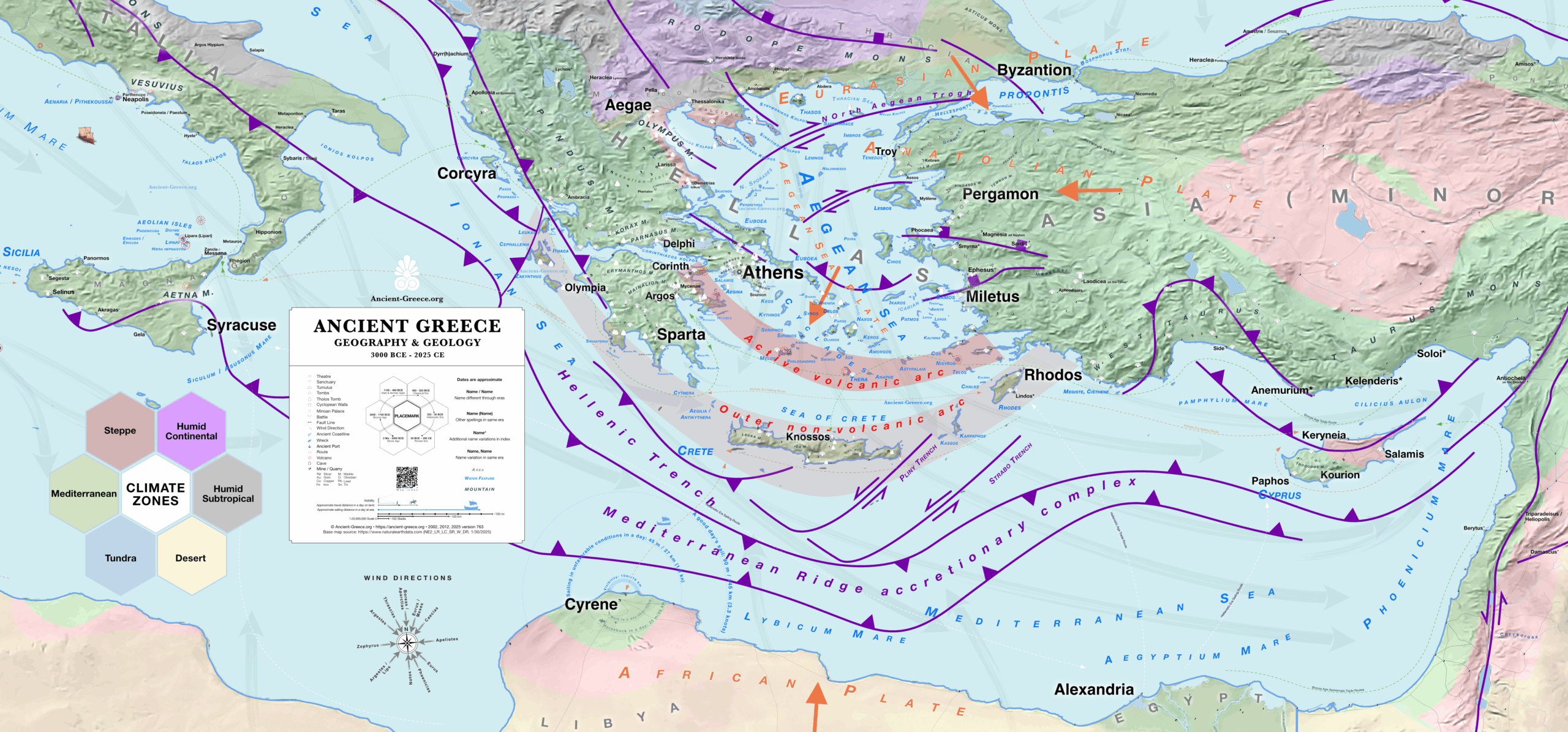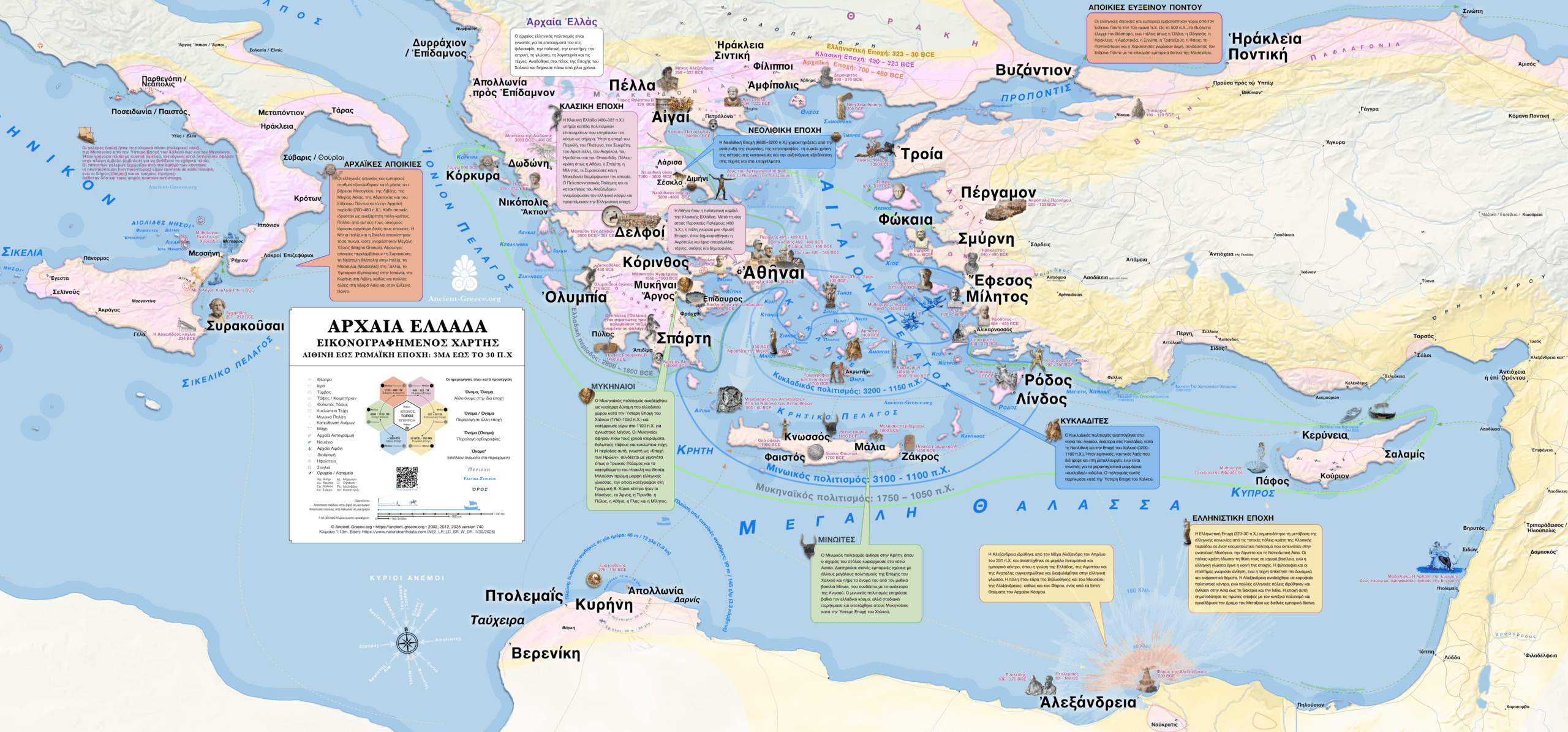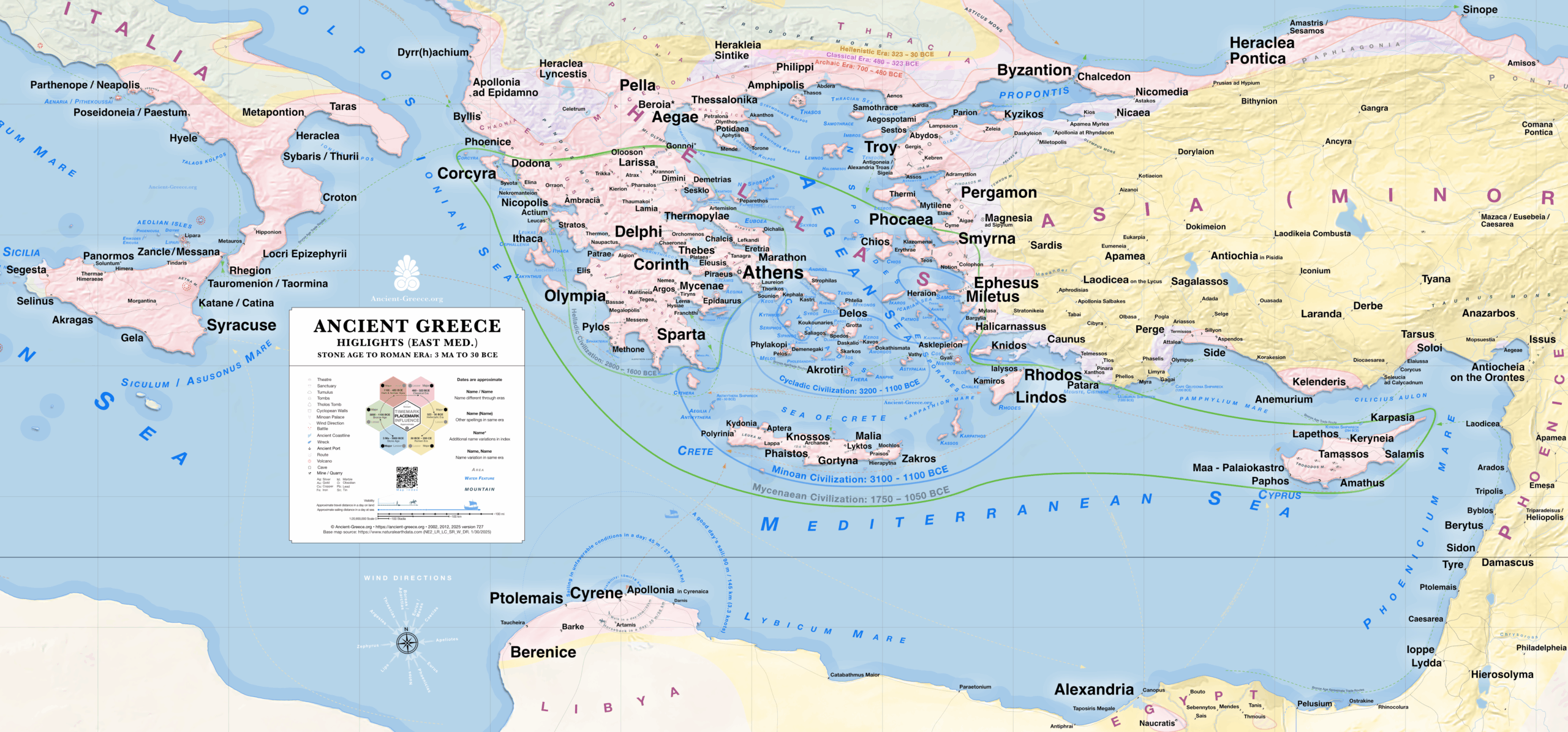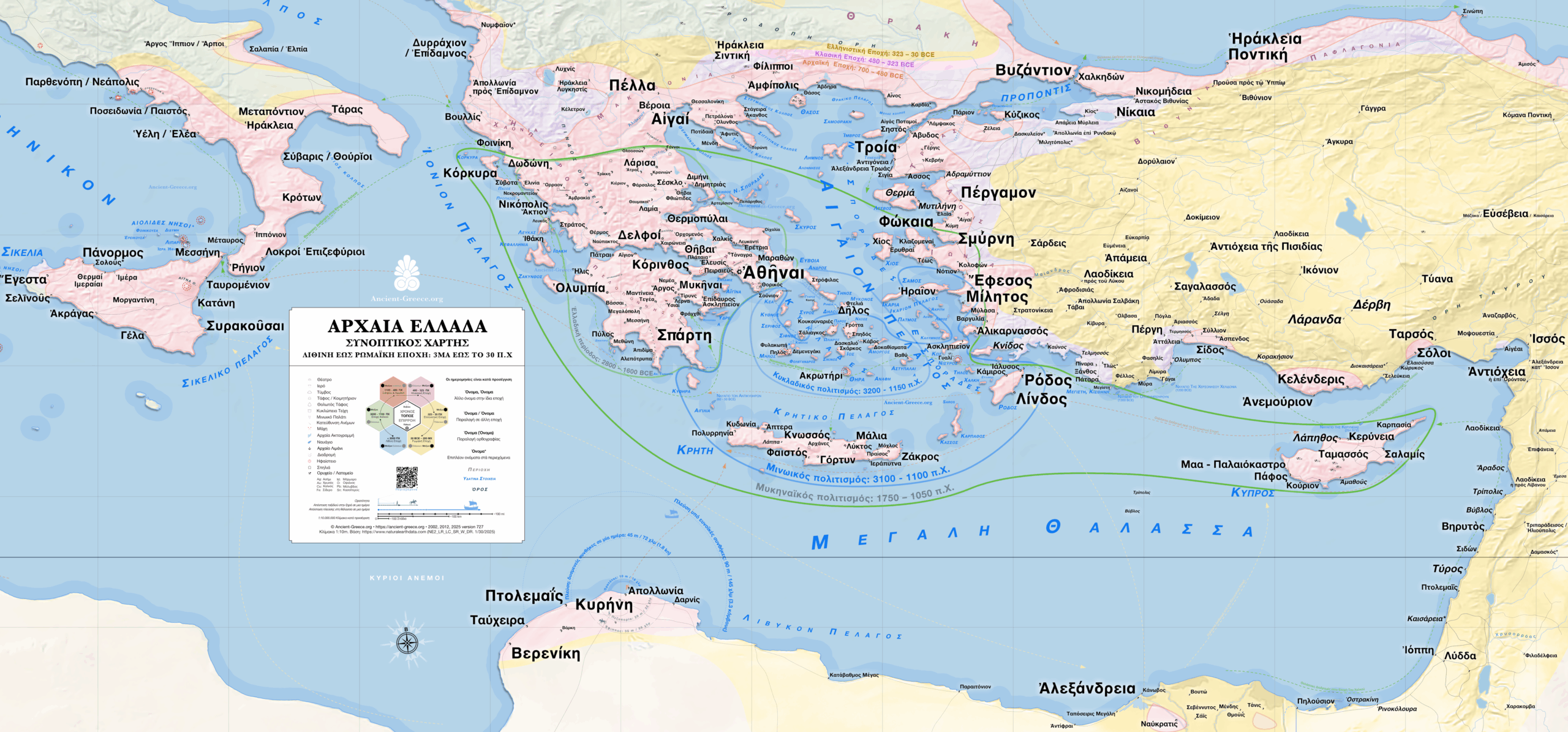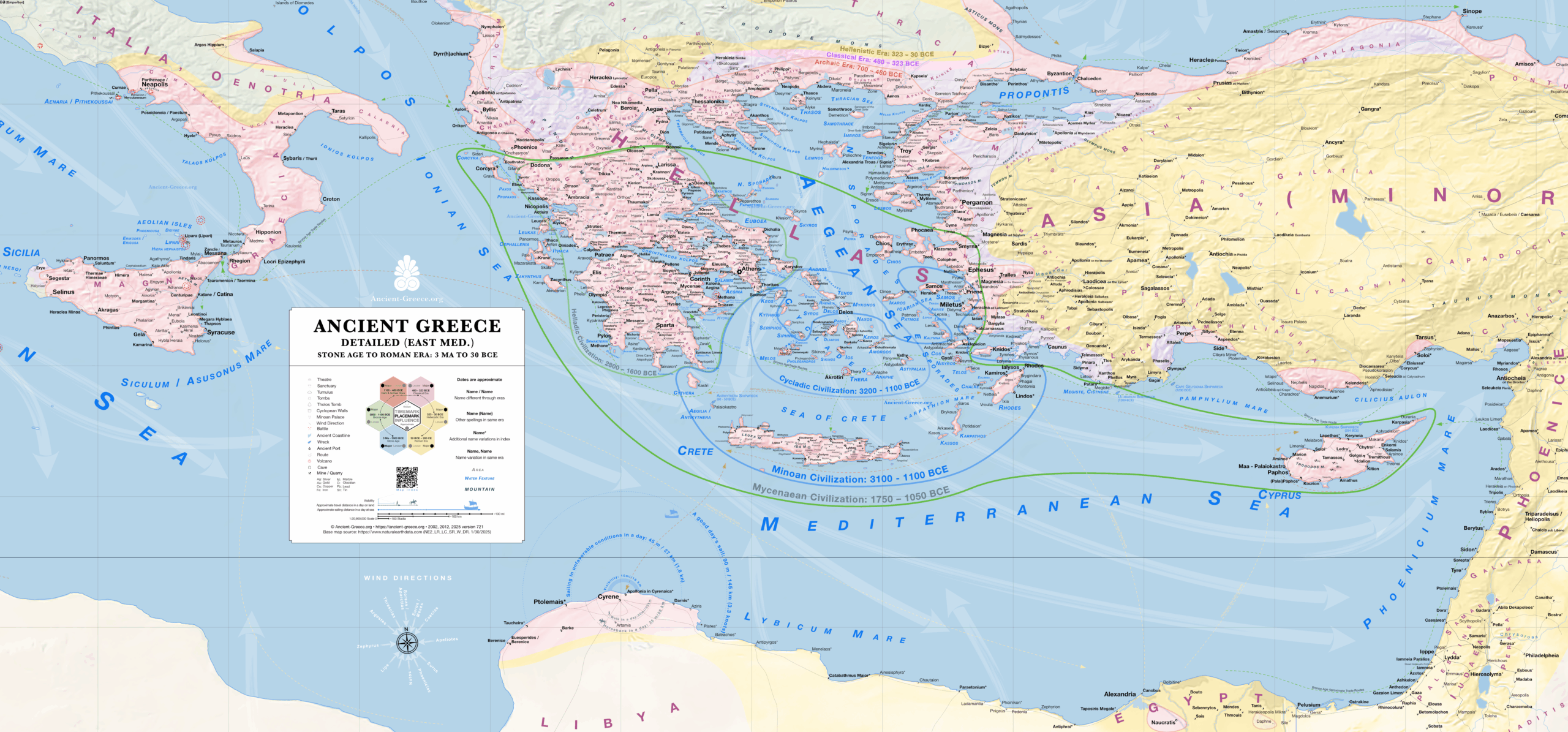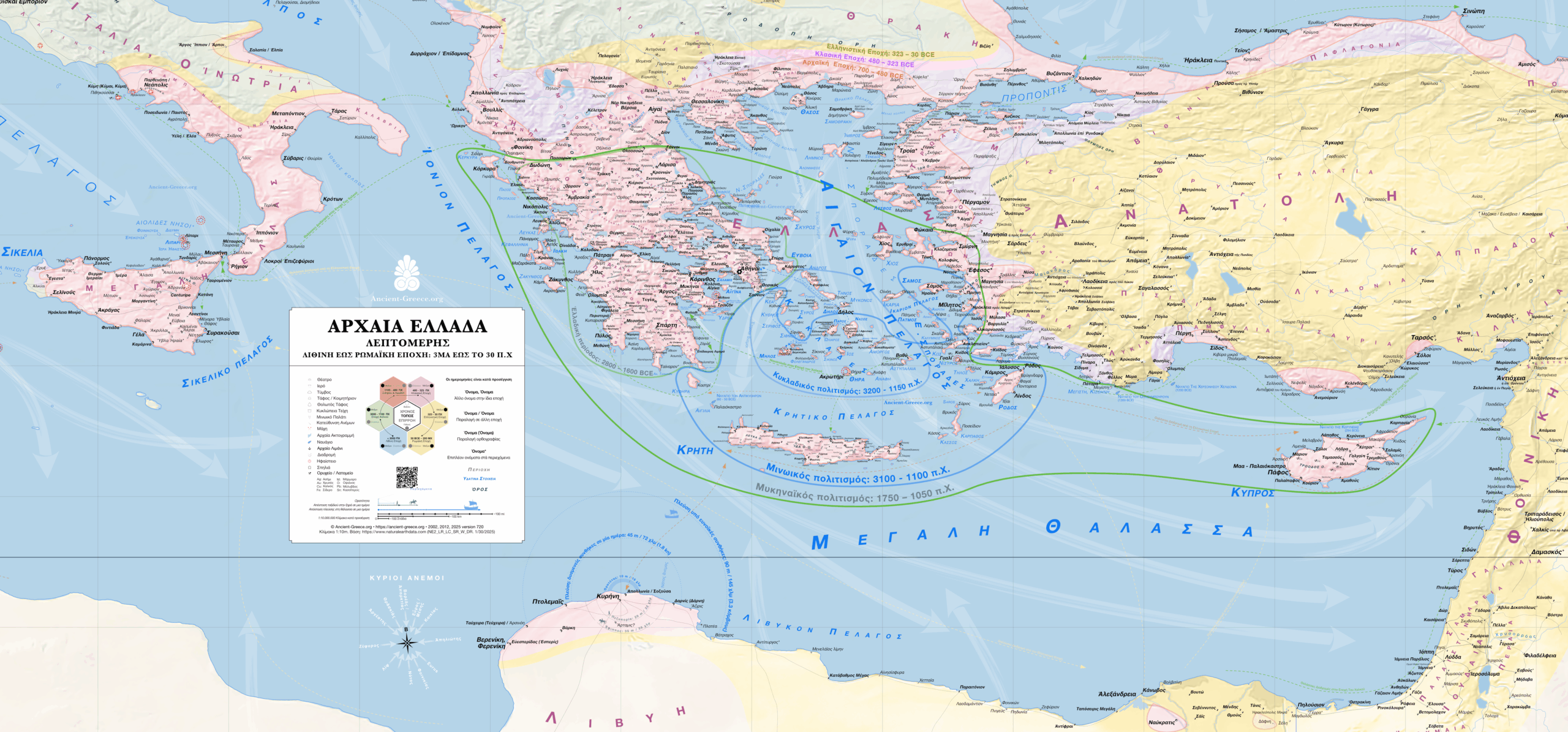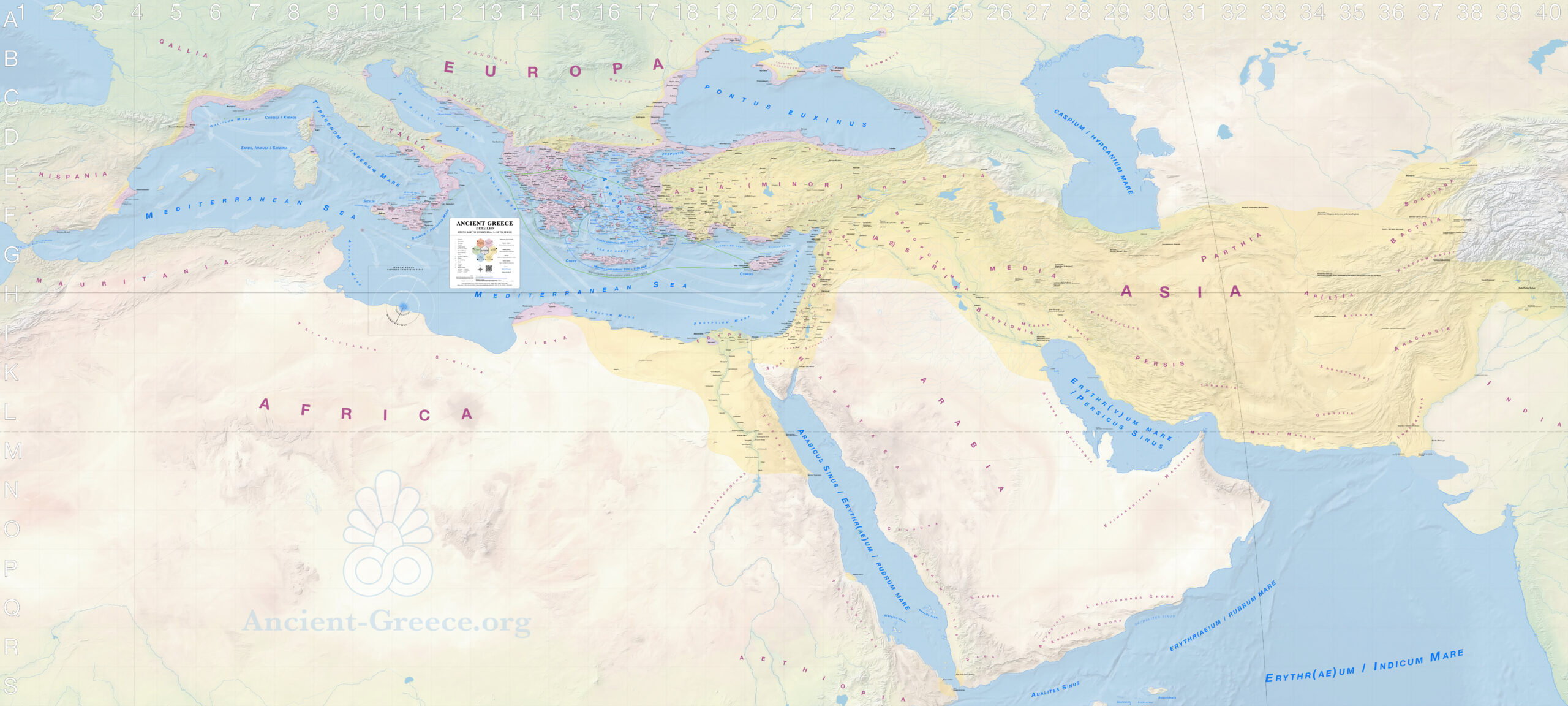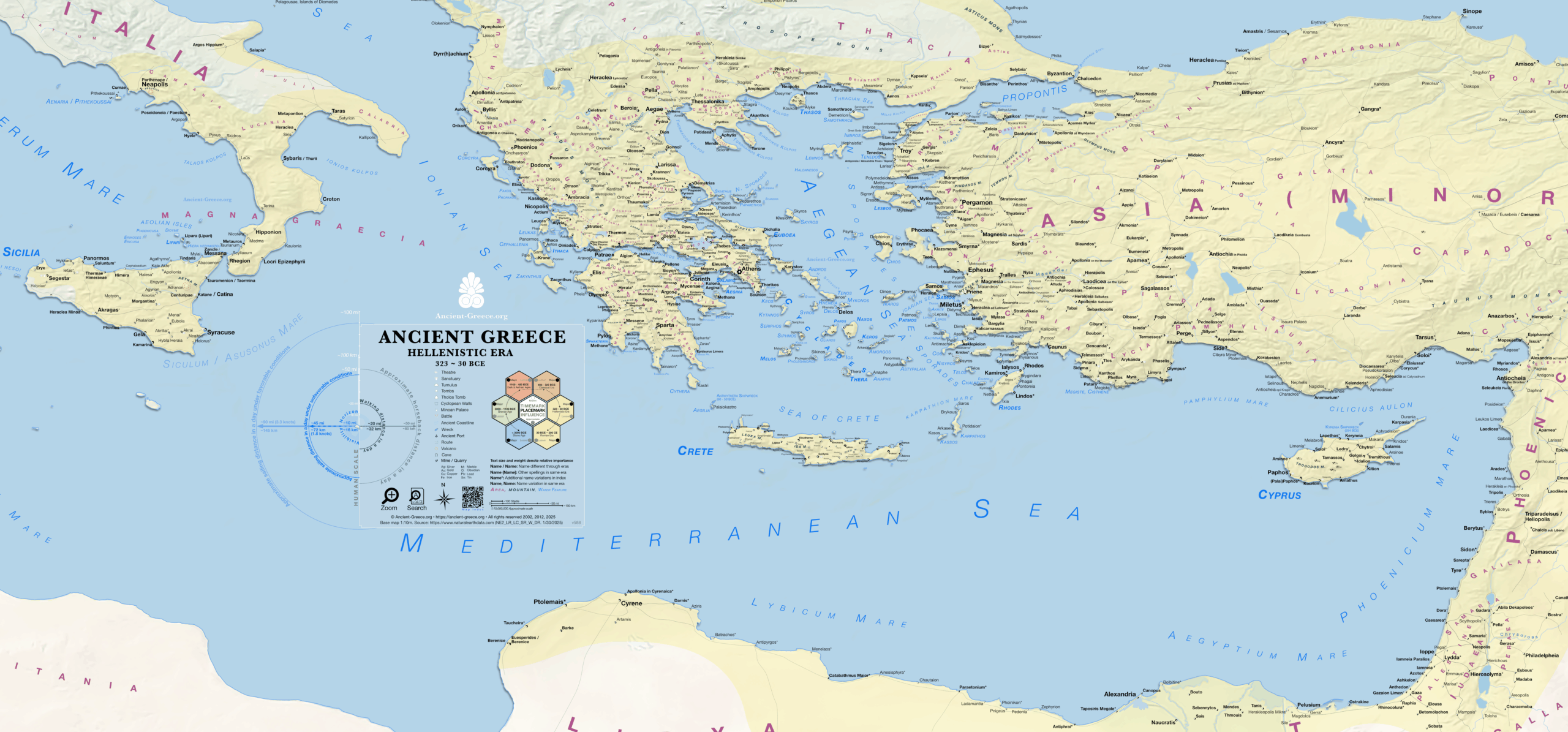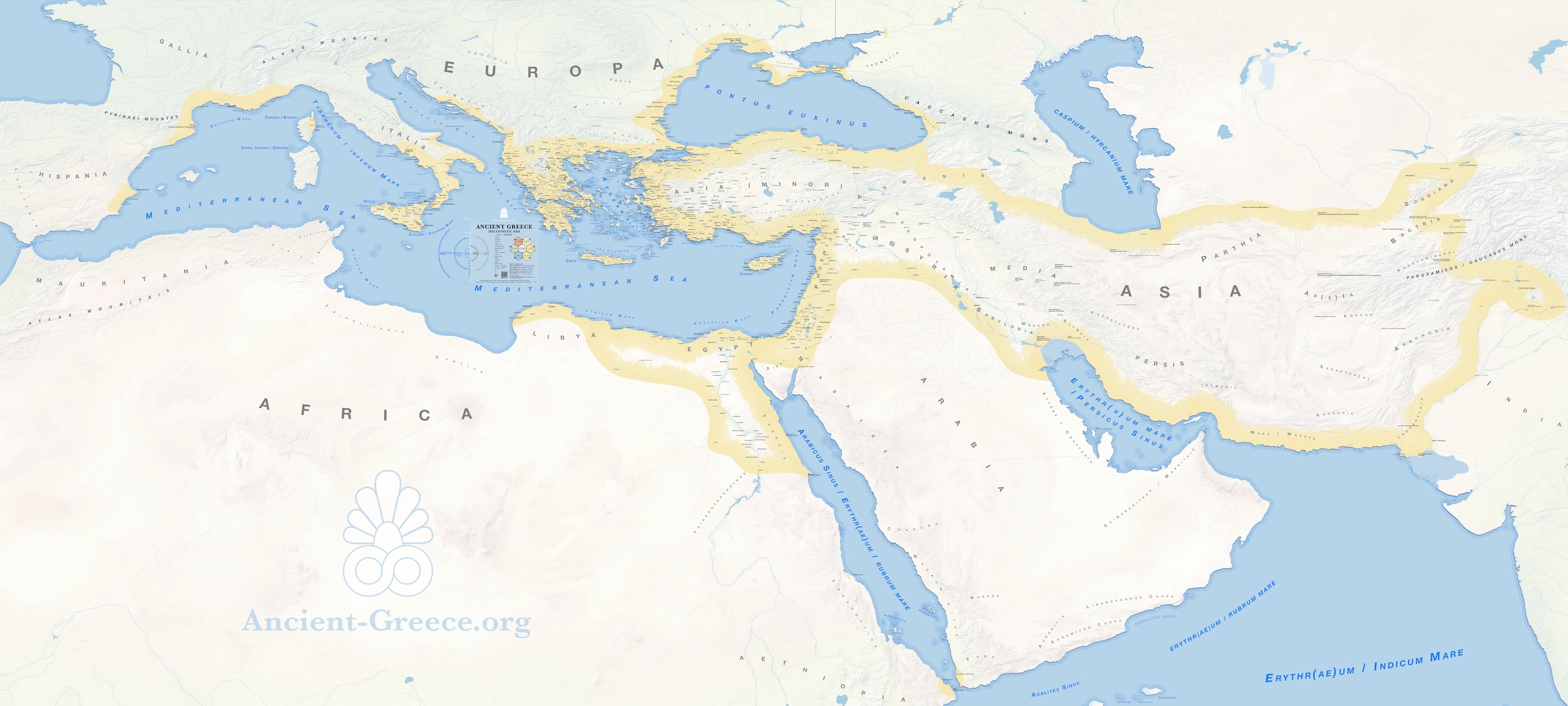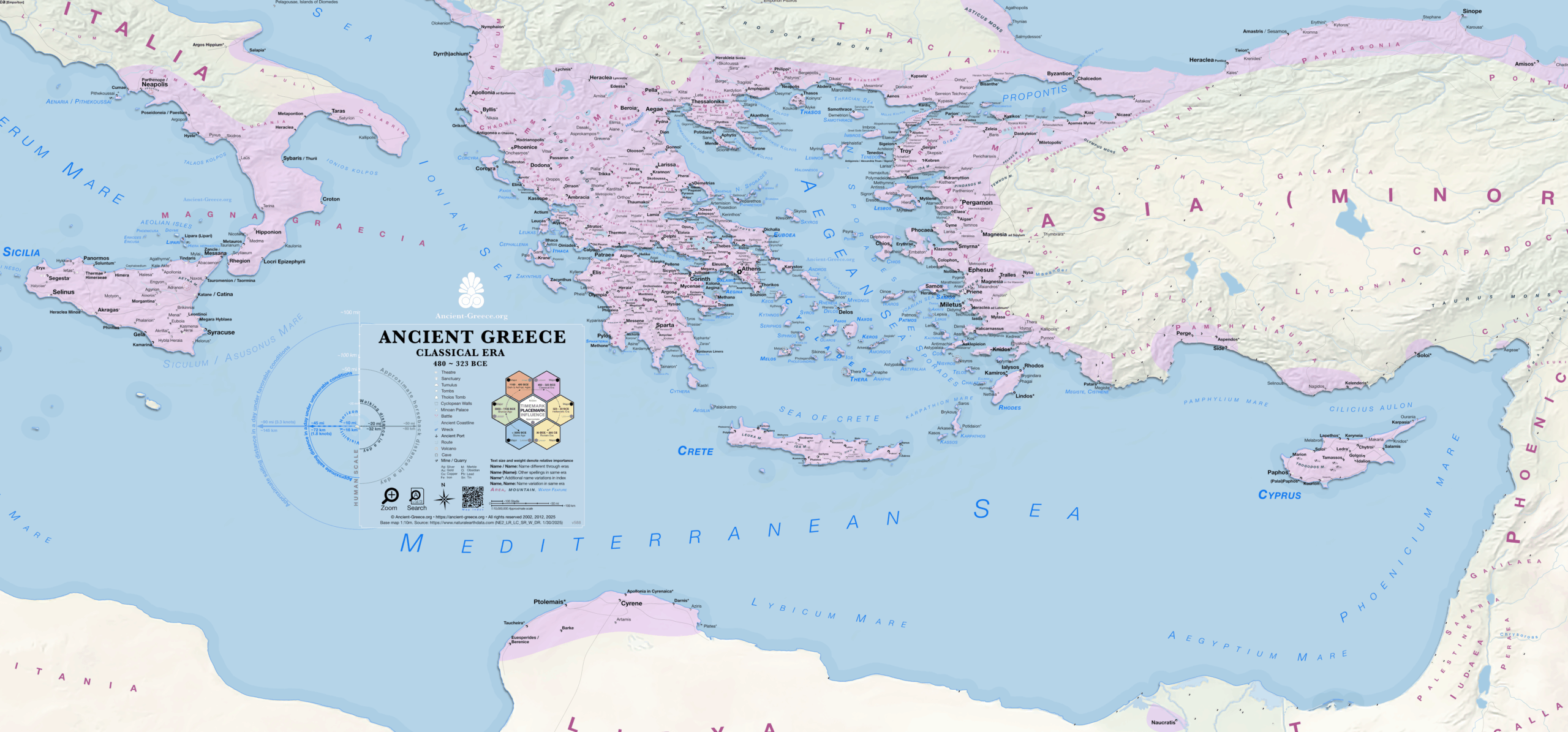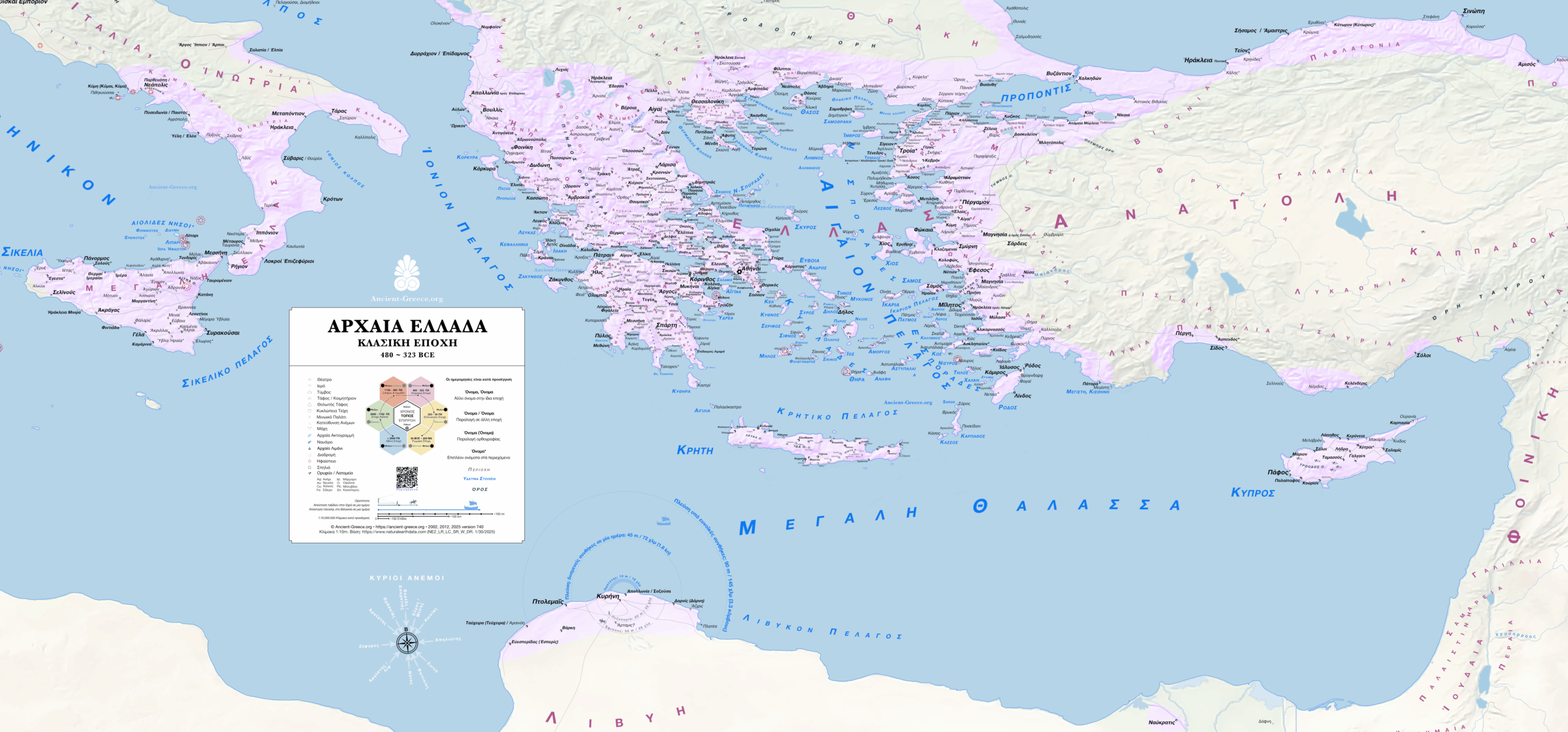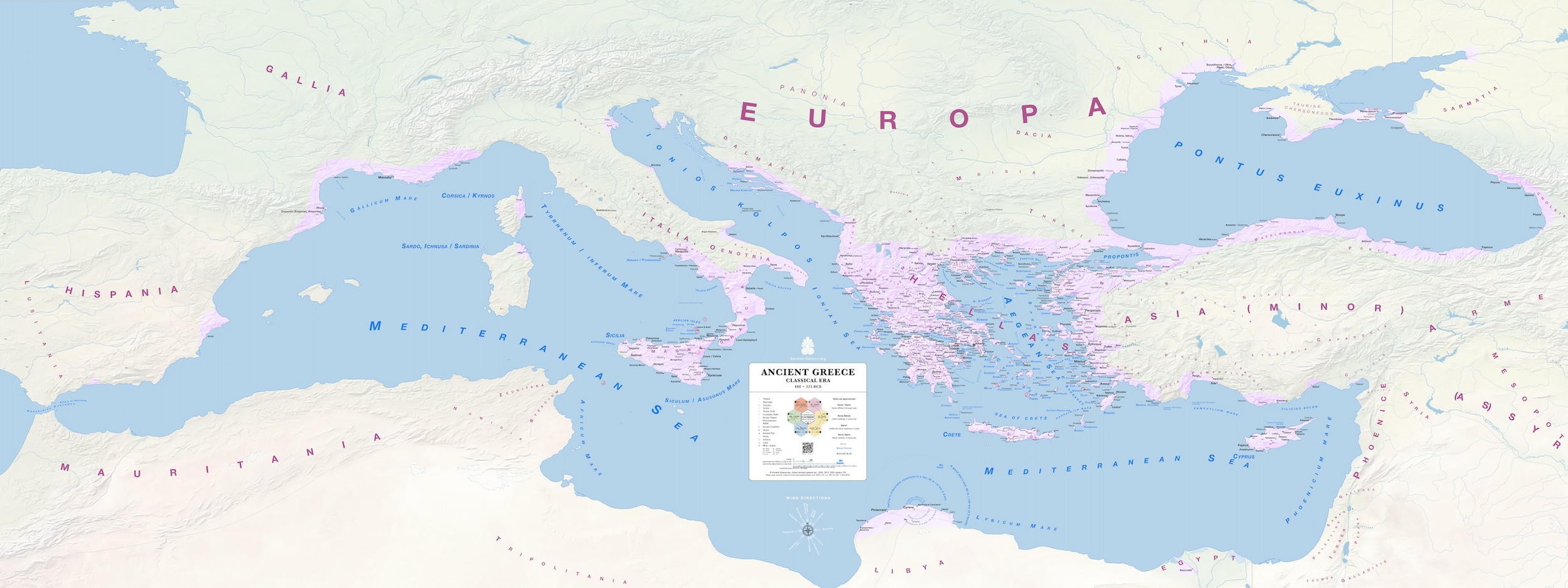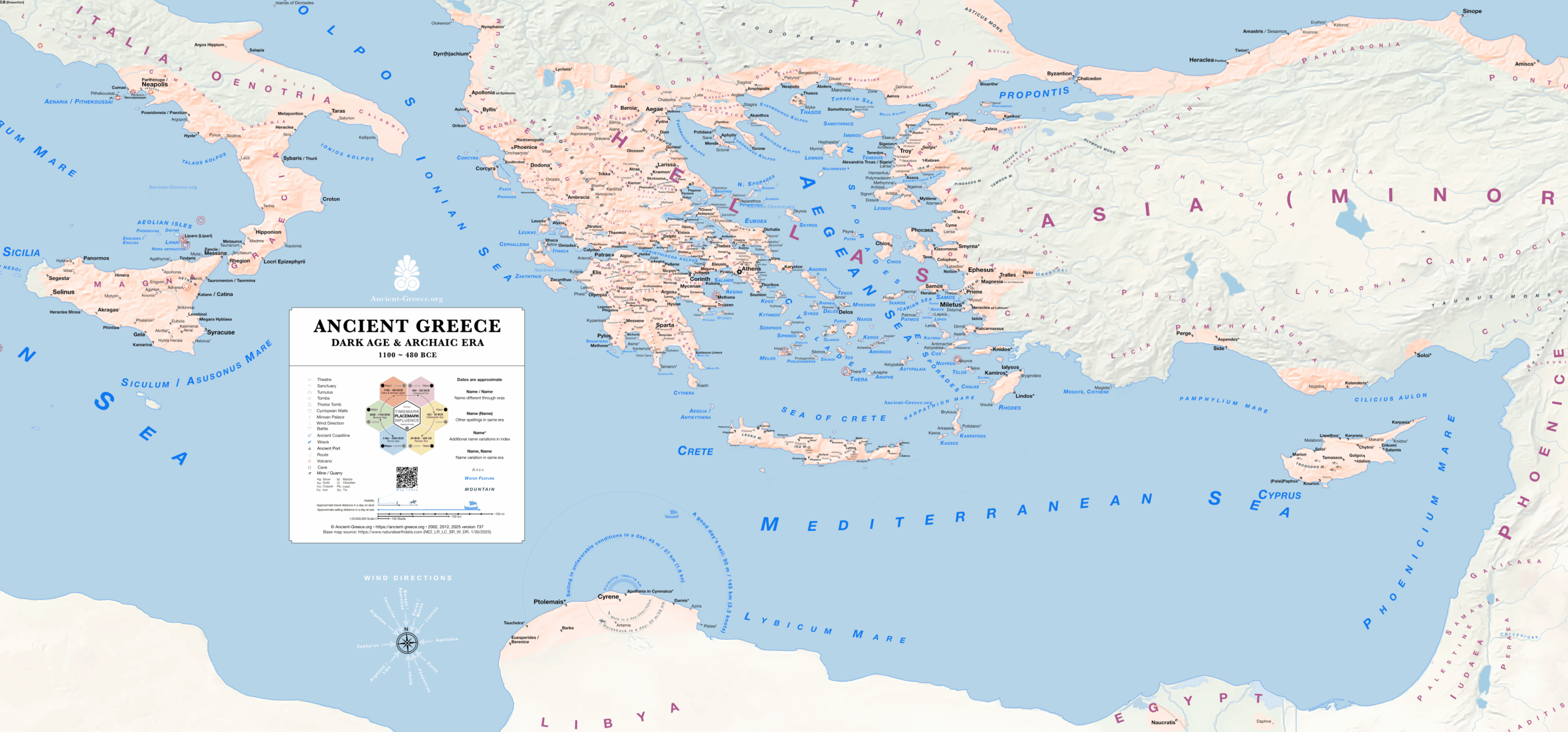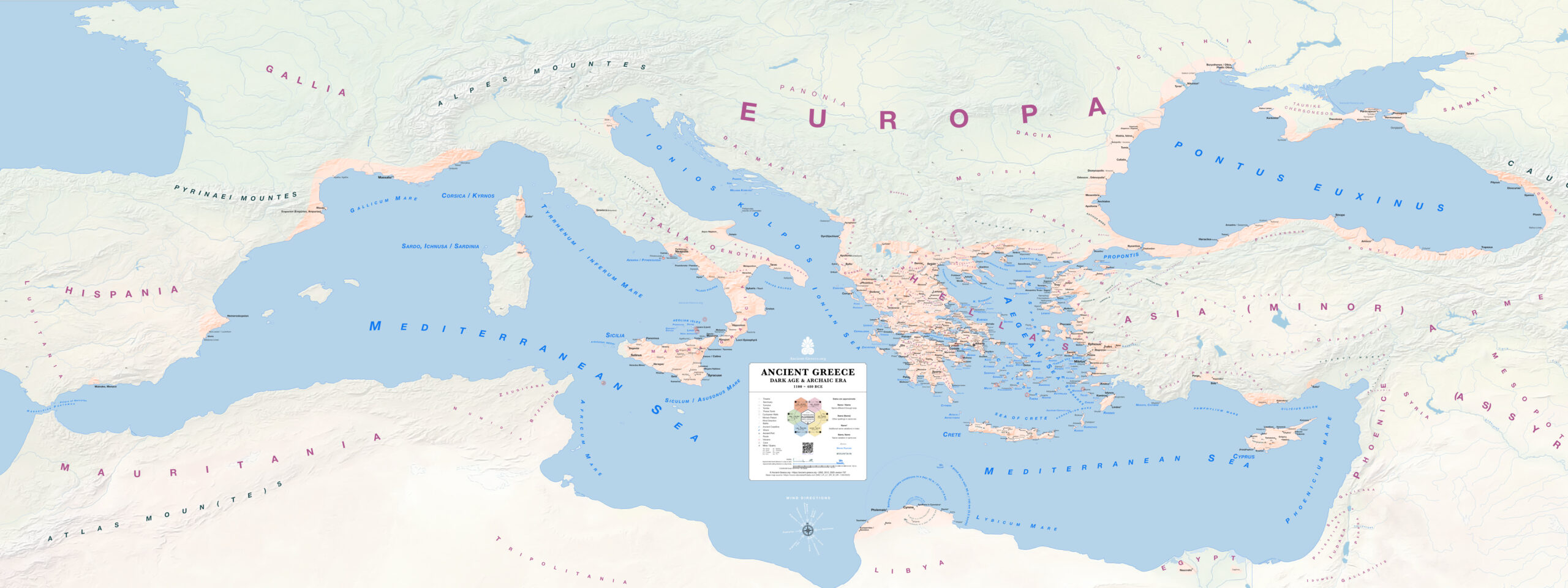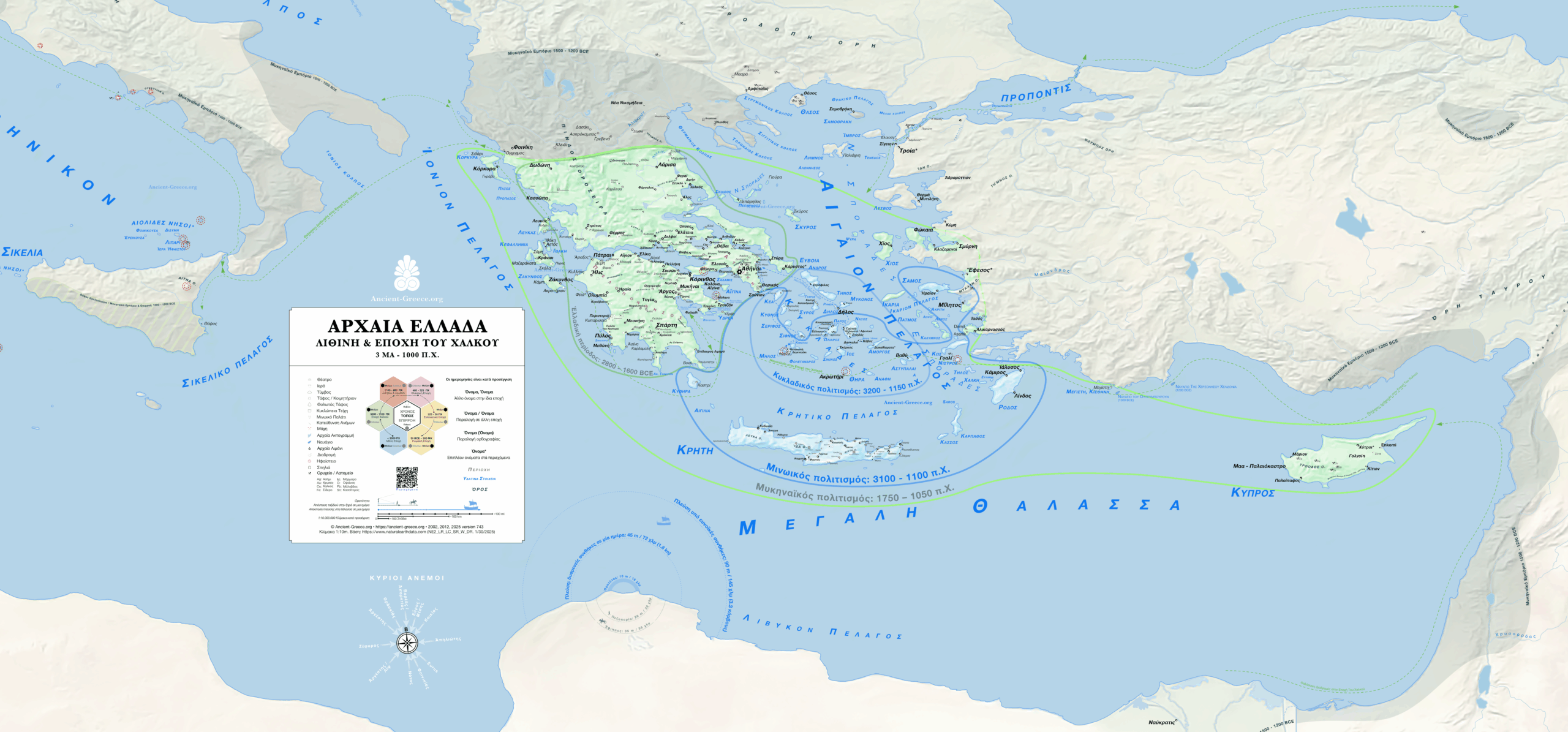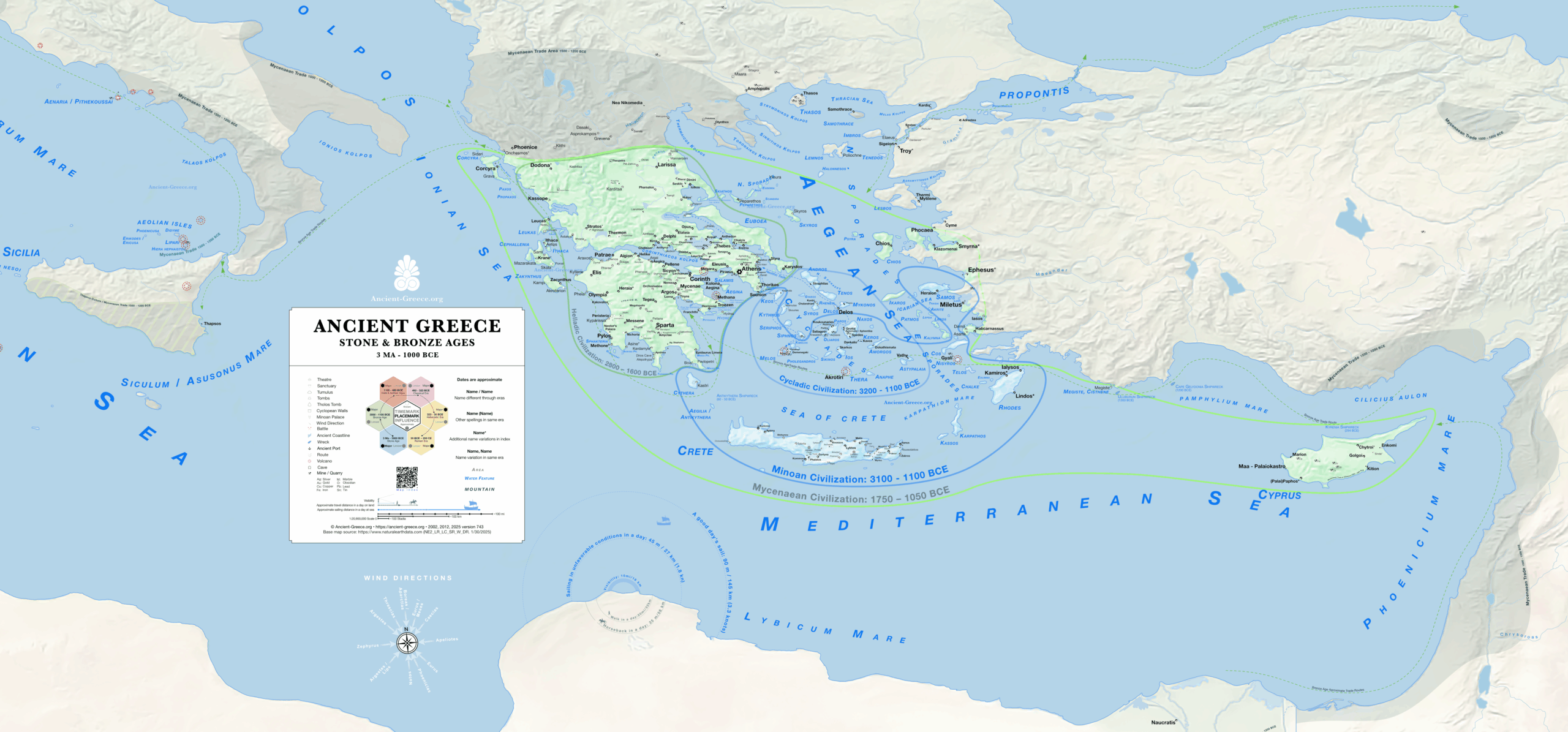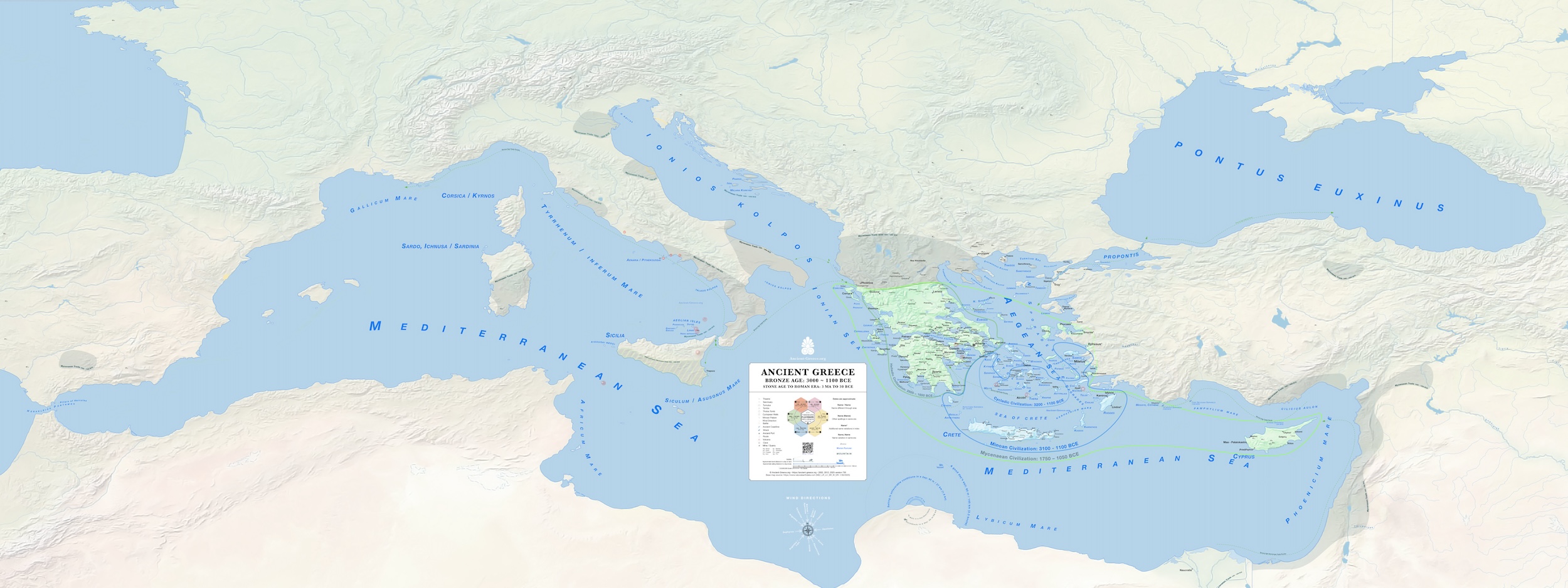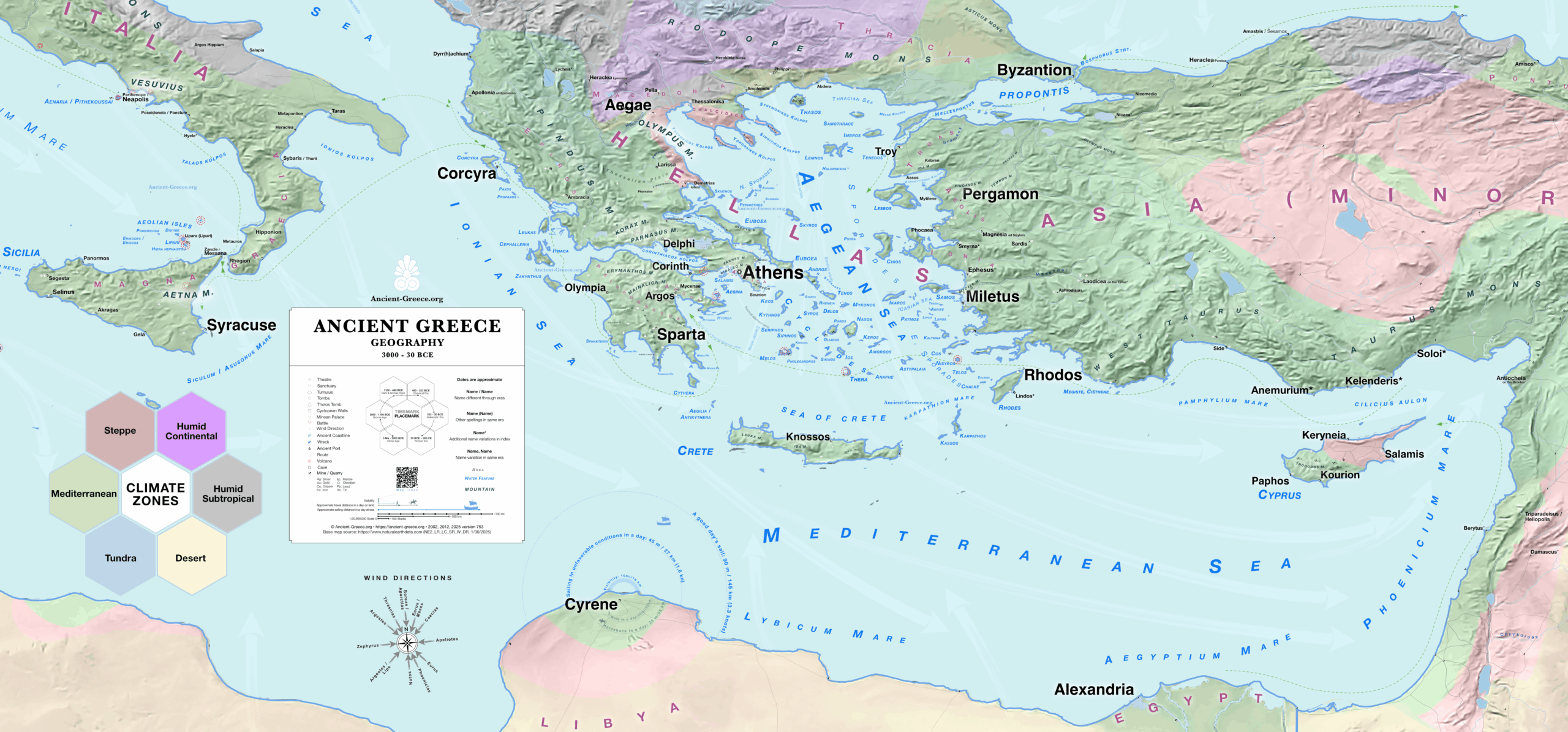Illustrated Map of Ancient Greece
Stone Age to Roman Era: 3 MA – 30 BCE
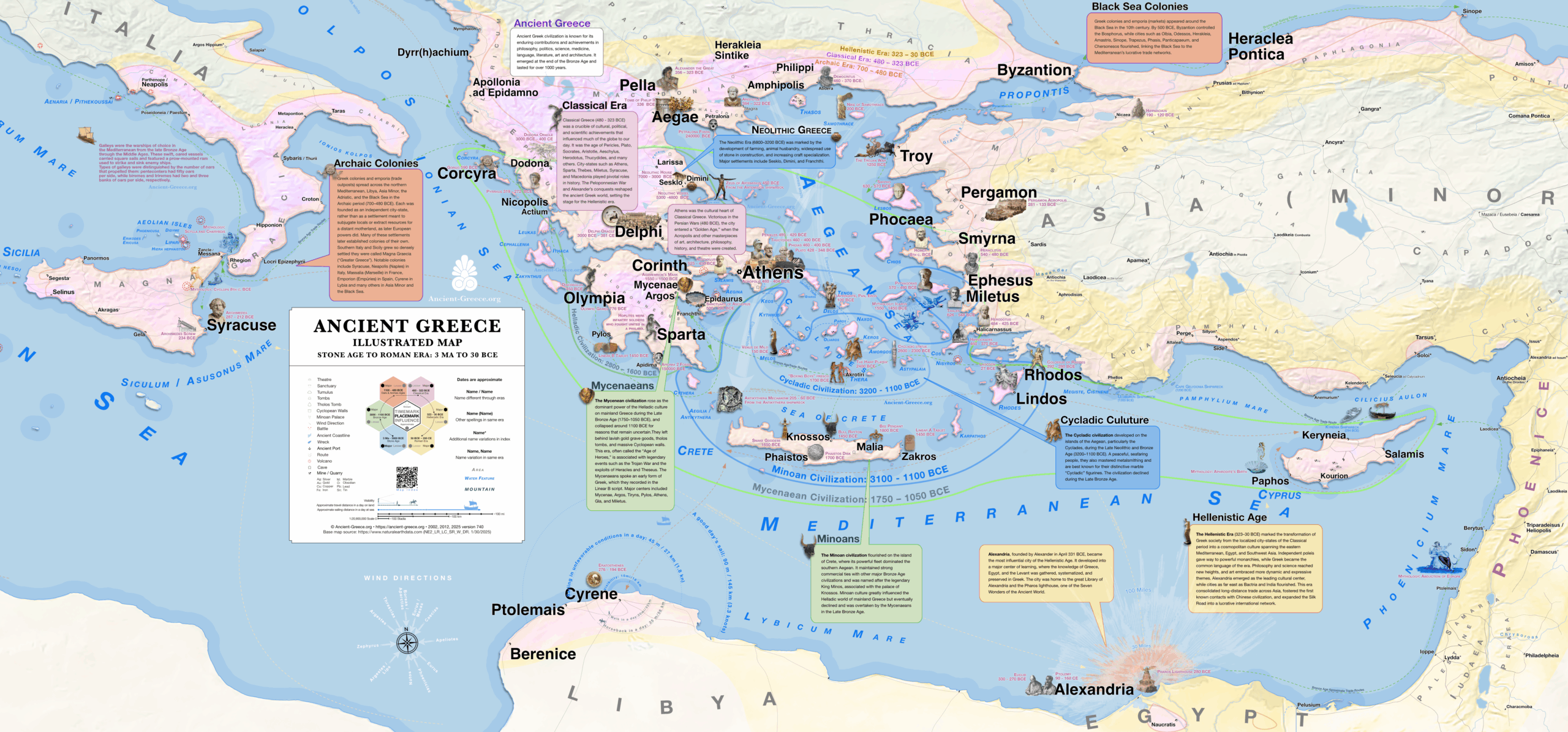
In Greek: Εικονογραφημένος Χάρτης της Αρχαίας Ελλάδας. 3 MA έως το 30 πΧ.
Contents:
- Index of places & sources
The database contains the directory of over 1700 settlements with additional names and sources for each. - Legend and design notes
Information on the map elements, design, and styles.
Detailed Maps
Detailed Map of Ancient Greece
Stone Age to Roman Era: 3 Ma – 30 BCE
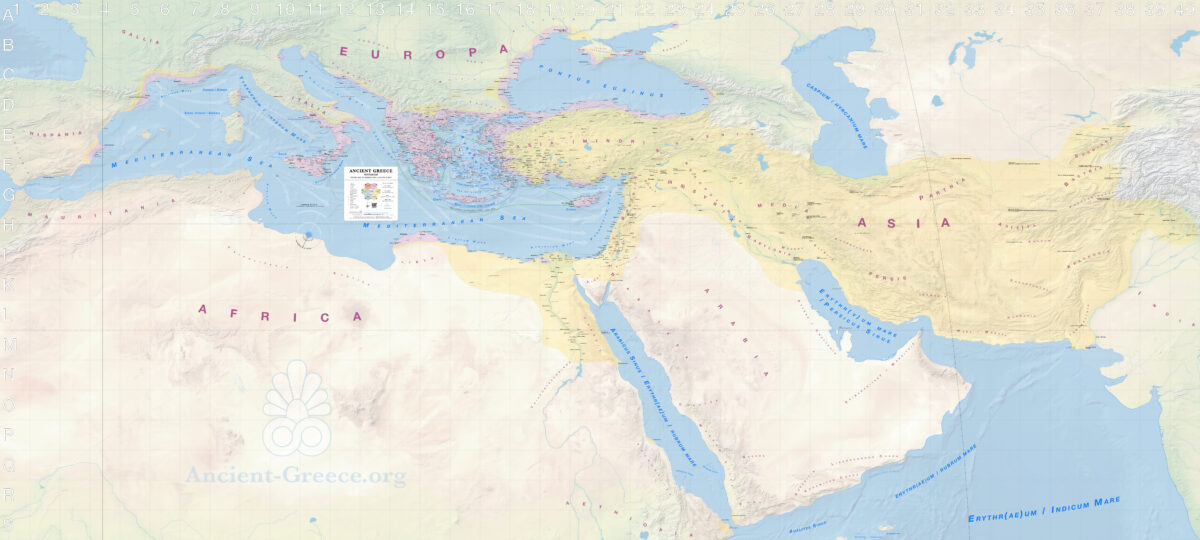
Detailed map of the Ancient Greece
Λεπτομερής Χάρτης της Αρχαίας Ελλάδας
Our most detailed and complete in area coverage map of Ancient Greece includes every place in the map index, from the Stone Age to the Roman Era, each hand-pinned after verification with trusted sources (also see the bibliography). In English and Greek.
PDF: Zoom x10, Search, Print 138.89 × 62.5 inches (352.78 × 158.75 cm). Printing note: Anything smaller than full size will have text too small to read.
Satellite View
3 MA ~ 200 CE
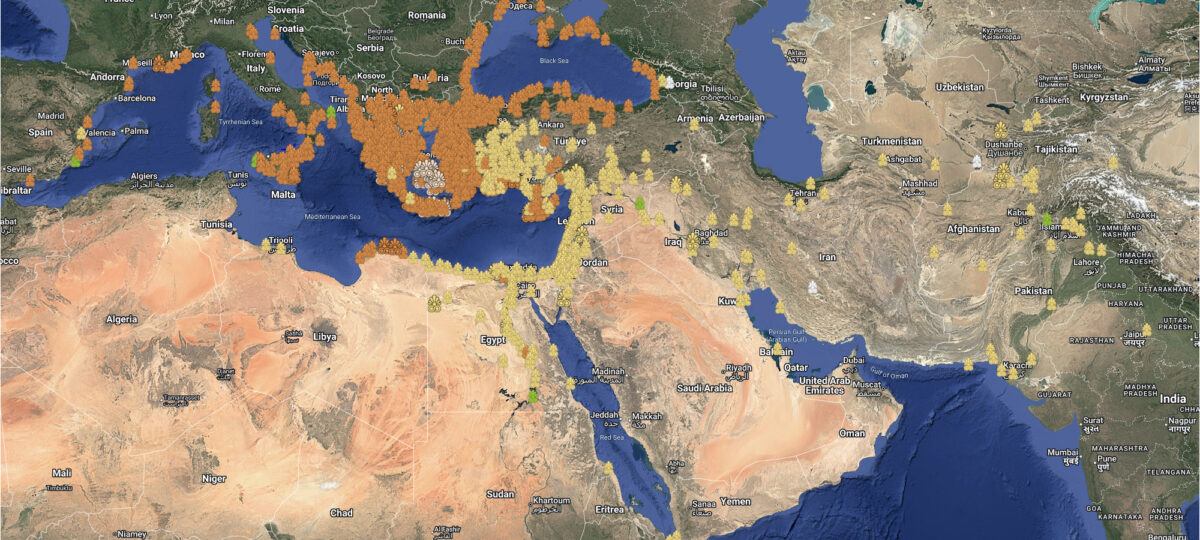
Ancient Greece on Google Maps
Ancient Greece on Google Earth
| Multiple eras | Stone Age | Bronze Age | Dark/Archaic Age | Classical Age | Hellenistic Age | Late Hellenistic / Roman |
 |  |  |  |  |  |  |
| 8000 – 3000 BCE | 3000 – 1000 BCE | 1000 – 480 BCE | 480 – 323 BCE | 323 – 146 BCE | 146BCE+ |
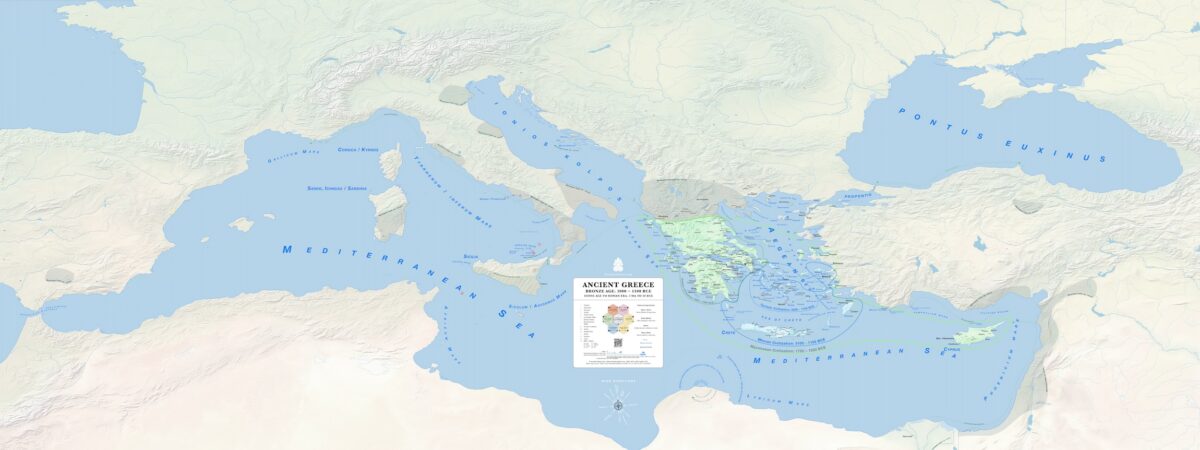
Original files:
Stone & Bronze Age civilizations: Cycladic, Minoan, Helladic, and Mycenaean
Λίθινη, και Εποχή του Χαλκού: Κυκλαδικός, Μινοϊκός, Ελλαδικός, και Μυκηναϊκός Πολιτισμός
3 Ma to 1100 BCE
PDF: Zoom x10, Search, Print 83.34 × 31.25 inches
211.68 × 79.37 cm
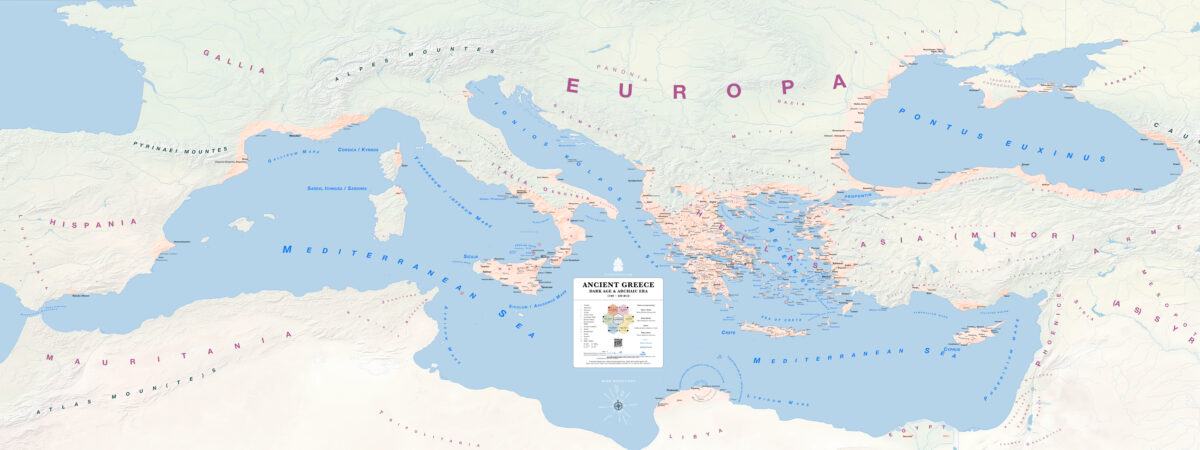
Original files:
Dark Age and Archaic Era Colonies
Σκοτεινη και Αρχαϊκή Εποχή
1100 – 480 BCE
PDF: Zoom x10, Search, Print 83.34 × 31.25 inches
211.68 × 79.37 cm
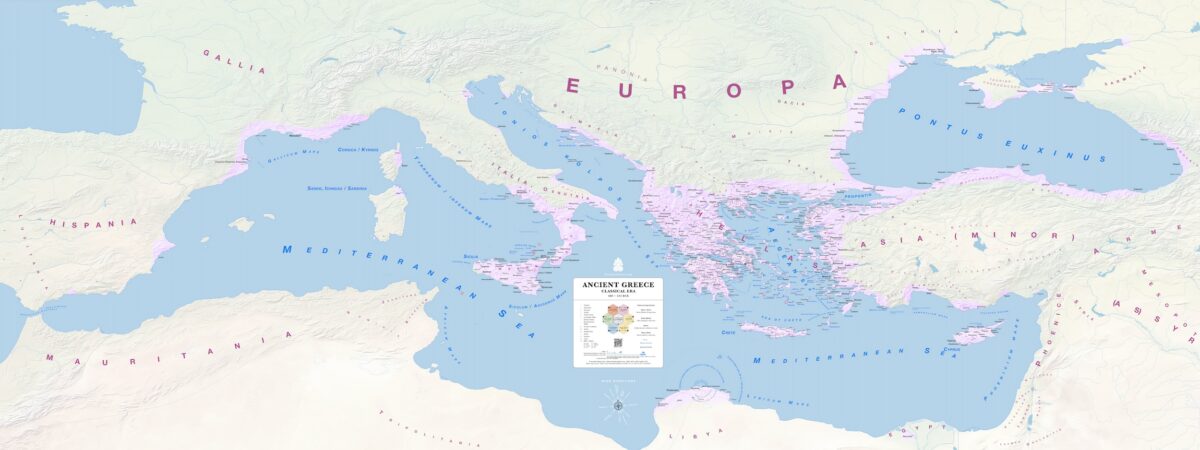
Original files:
Classical Greece
Κλασική Εποχή
480 to 323 BCE
PDF: Zoom x10, Search, Print 83.34 × 31.25 inches
211.68 × 79.37 cm
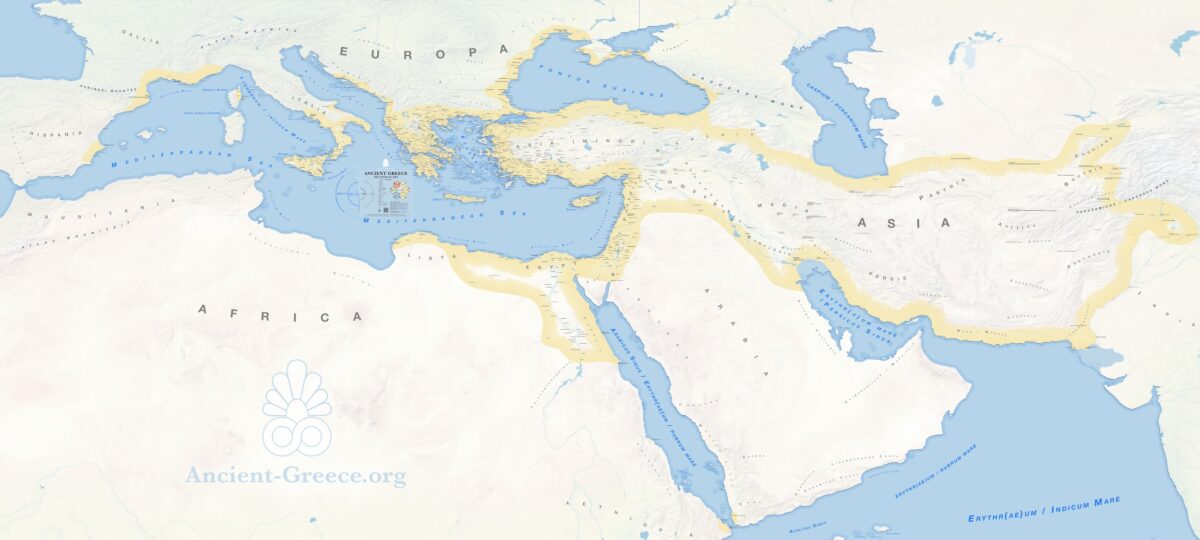
Original files:
Hellenistic Era
Ελληνιστική Εποχή
323 BCE to 200 CE
PDF: Zoom x10, Search, Print 138.89 × 62.5 inches
352.78 × 158.75 cm
Abridged Editions
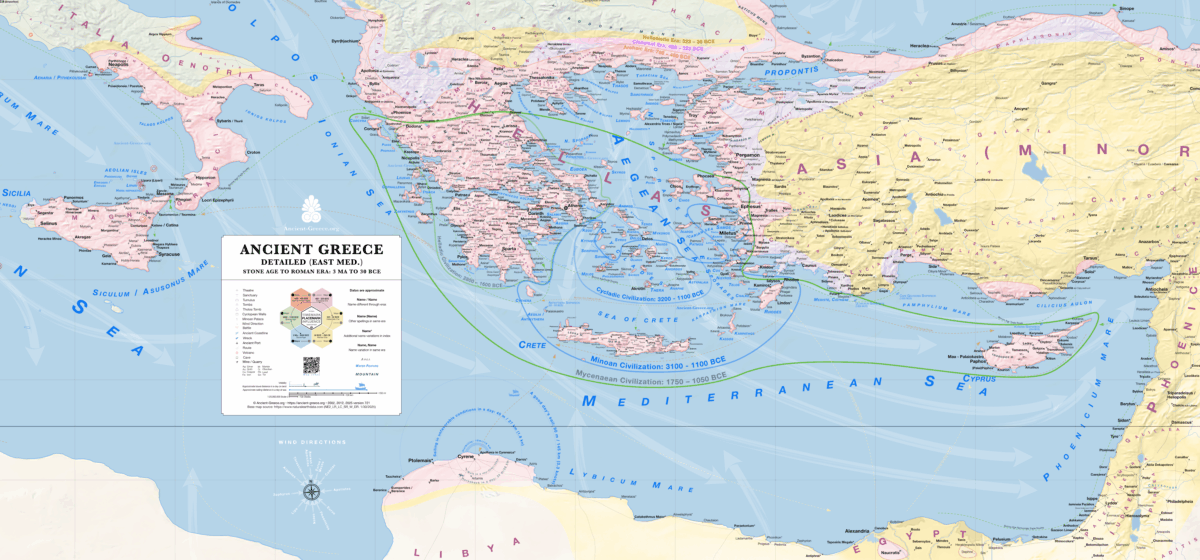
Original files:
Detailed Map of Ancient Greece
Λεπτομερής Χάρτης της Αρχαίας Ελλάδας
3 MA to 30 BCE
PNG: Zoom x4, Print 41.64 × 19.43 inches (105.76 × 49.35 cm)
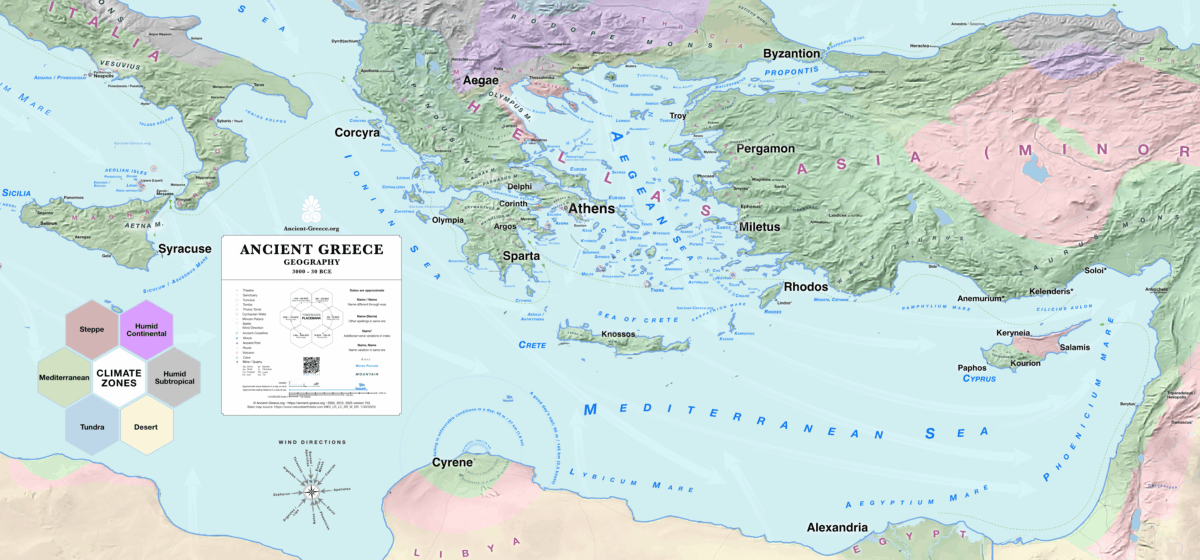
Original files:
Geography
3000 to 30 BCE
PNG: Zoom x4, Print 41.64 × 19.43 inches (105.76 × 49.35 cm)
PNG: Zoom x4, Print 41.64 × 19.43 inches (105.76 × 49.35 cm)
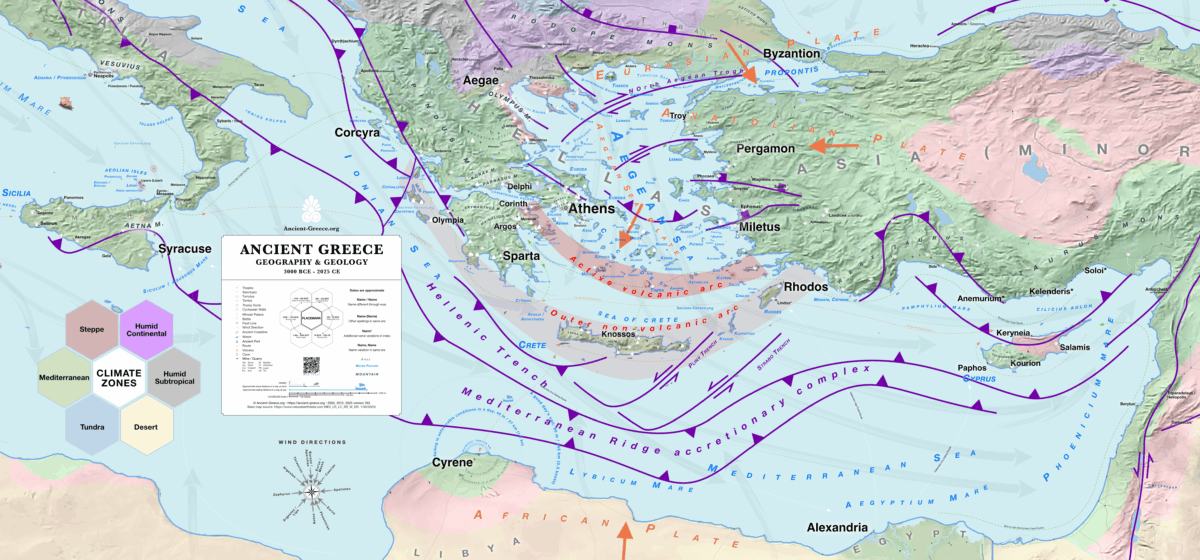
Original files:
Geography and Geology
3000 BCE to 2025 CE
PNG: Zoom x4, Print 41.64 × 19.43 inches (105.76 × 49.35 cm)
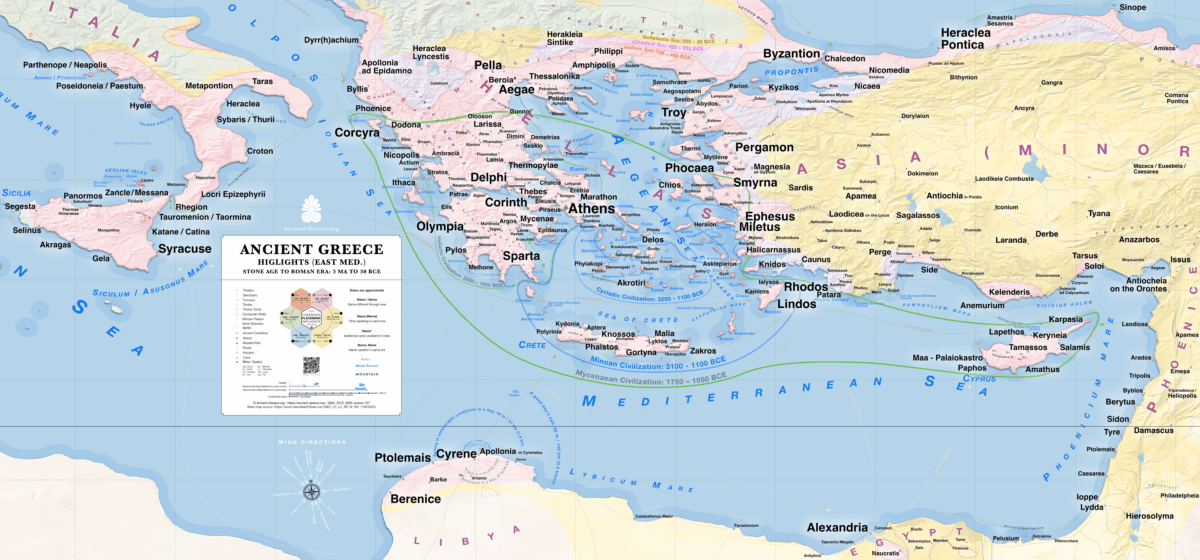
Original files:
Highlights from All Eras
Συνοπτικός χάρτης της Αρχαίας Ελλάδας
3 MA to 30 BCE
PNG: Zoom x4, Print 41.64 × 19.43 inches (105.76 × 49.35 cm).
PNG: Zoom x4, Print 41.64 × 19.43 inches (105.76 × 49.35 cm)
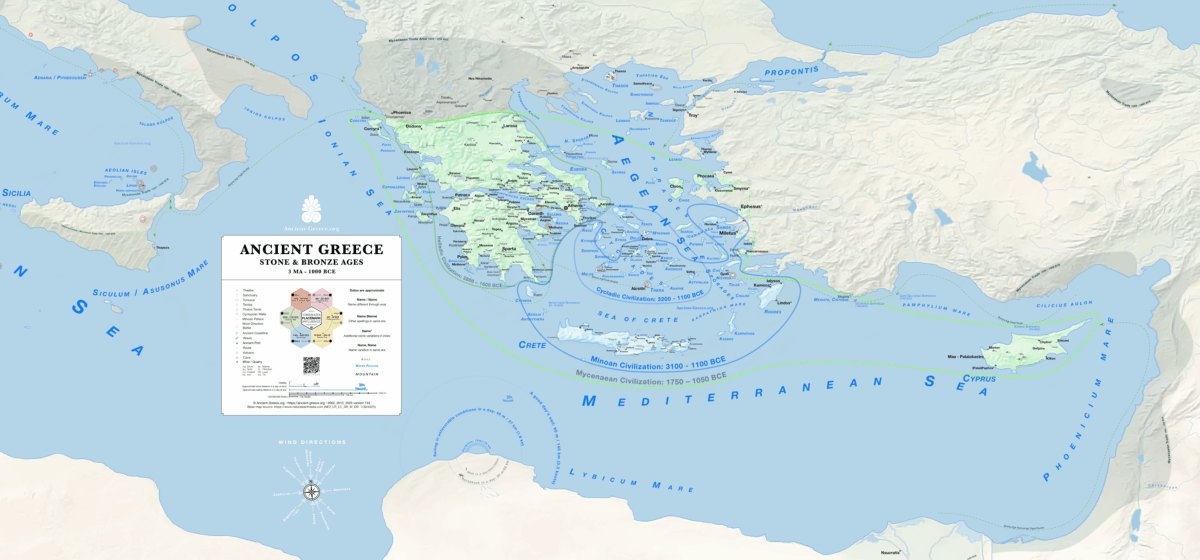
Original files:
Stone & Bronze Ages: Cycladic, Minoan, Helladic, and Mycenaean civilizations
Λίθινη, και Εποχή του Χαλκού: Κυκλαδικός, Μινοϊκός, Ελλαδικός, και Μυκηναϊκός Πολιτισμός
3MA to 1100 BCE
PNG: Zoom x4, Print 41.64 × 19.43 inches (105.76 × 49.35 cm)
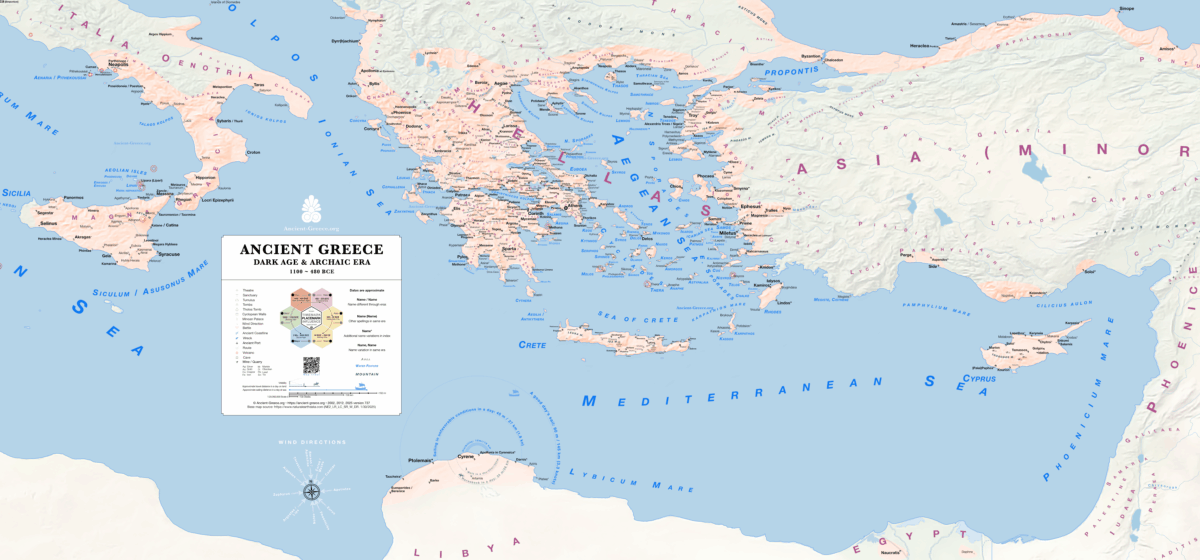
Original files:
Dark Age and Archaic era Colonies
Η Αρχαία Ελλάδα κατά τον Σκοτεινό αιώνα και την Αρχαϊκή εποχή
1100 – 480 BCE
PNG: Zoom x4, Print 41.64 × 19.43 inches (105.76 × 49.35 cm)
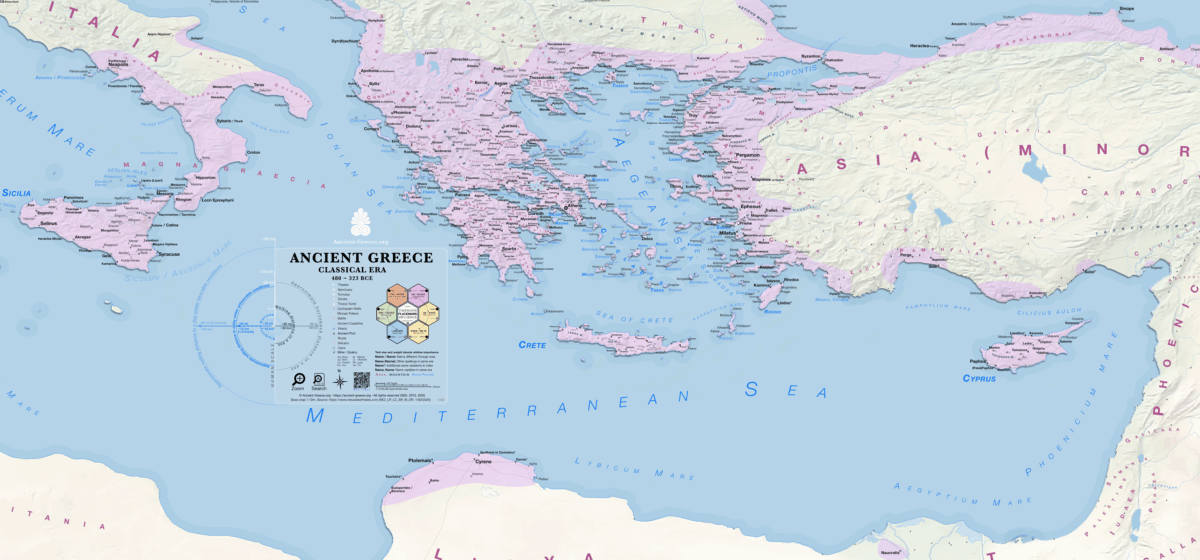
Original files:
Classical Greece
Κλασική Εποχή
480 to 323 BCE
PNG: Zoom x4, Print 41.64 × 19.43 inches (105.76 × 49.35 cm)
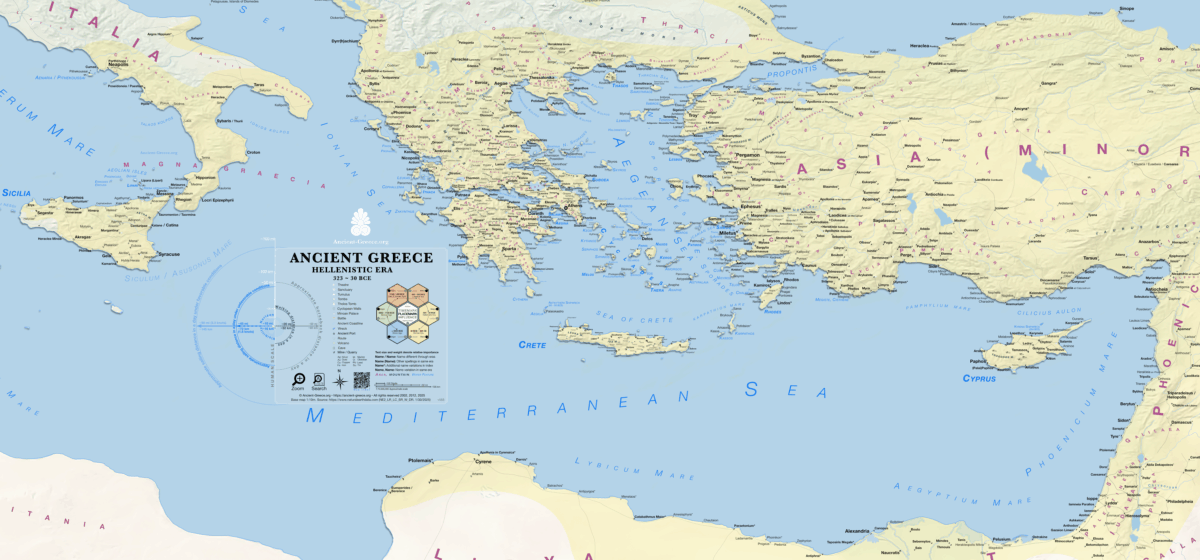
Original files:
Hellenistic Era
323 BCE to 30 CE
PNG: Zoom x4, Print 41.64 × 19.43 inches (105.76 × 49.35 cm)
Map Gallery
This slideshow illustrates Ancient Greece through map previews.
For high quality maps and to see more details, open or download the free original files found on this page.
About
The maps include places which were predominantly settled, or were centers of Greek influence, Hellenized, or administered by Greeks, from the Stone Age to the Roman Era (pre-3000 BCE to about 200 CE). Pre-Bronze Age places, are included for continuity and context in certain areas.
The complete, detailed map includes settlements and features in the Mediterranean, the Black Sea, the Levant, Egypt, Mesopotamia, Parthia, Bactria, and India. Thematic maps are published individually to illuminate different aspects of antiquity, areas, events and historical periods.
The work’s scope is to create a comprehensive map of Ancient Greece by including all known and probable locations (in the author’s knowledge) and, in the process, reviewing and verifying each place with trusted sources. Map index, Bibliography
These maps are part of the author’s research Ancient Greece and information design, and are crafted the old-fashioned way: designing the base map, then hovering over the ancient landscape, discovering facts, and hand-pinning one dot at a time.
The design aims to be pleasing to the eye, both on digital screens and in print, and importantly, to have longevity as a free resource.
Most ancient-greece.org maps pay homage to the style of hand-printed wall maps found in old primary schools and geography textbooks, though a few thematic maps feature experimental color combinations.
Development began in 2002, and the project reached its maturity in 2025, in version 400, with a new base map and 99% of settlements verified and pinned. Work continues with corrections, refinements and newly-researched additions.


